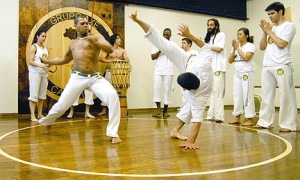
Brazilian defence game capoeira vaulting into the spotlight
A spontaneous backflip flowing flawlessly into a swift leg sweep and finishing with an evasive cartwheel — capoeira transcends the laws of gravity.
But the whirlwind of moves from the 400-year-old martial art disguised as a dance game is still relatively unknown.
Originally a form of self-defence created by Brazilian slaves, the fact it is not mainstream doesn’t dishearten Marcos Martins, Instructor Paraiba at Axé Capoeira Toronto.
“I would say it’s growing really fast right now,” he said of capoeira’s visibility. “And I think it’s just a matter of time before everybody really knows about it.”
With mixed martial arts growing in popularity, and more attention from Hollywood and video games, Martins said the capoeira community is worried it might lose its roots.
However, he credited video games — Tekken in particular — for spreading the word.
“I think that Tekken, in terms of promoting capoeira, is one of the best things that’s happened, even though the movements don’t reflect the reality of capoeira,” he said. “A lot of the people that have seen capoeira, besides a live presentation, have seen it through Tekken.”
That extra media attention is what drew in Newmarket high school student Ali Razavi.
He purchased some videos and tried to copy capoeira moves with little success. So he searched online and discovered Axé.
“It’s awesome,” he said, taking a breather from practice. “I’d like to come out more often, but (I can’t) because of high school.”
Razavi, who started in January, travels two hours from his home to class.
In order to get more people interested in the Brazilian martial art, Martins has organized a boot camp to introduce new students to it.
Starting May 7, the camp puts emphasis on whipping people into shape, targeting the three major areas used: legs, core and upper body.
But don’t expect to get capoeira’s version of the black belt, branco, in a short period of time.
“What you would see in karate, for example, is 15- or 16-year-olds with black belts,” Martins said. “That’s something you would never see in capoeira.
“To become a mestre, you would need at least 20 years of experience.”
